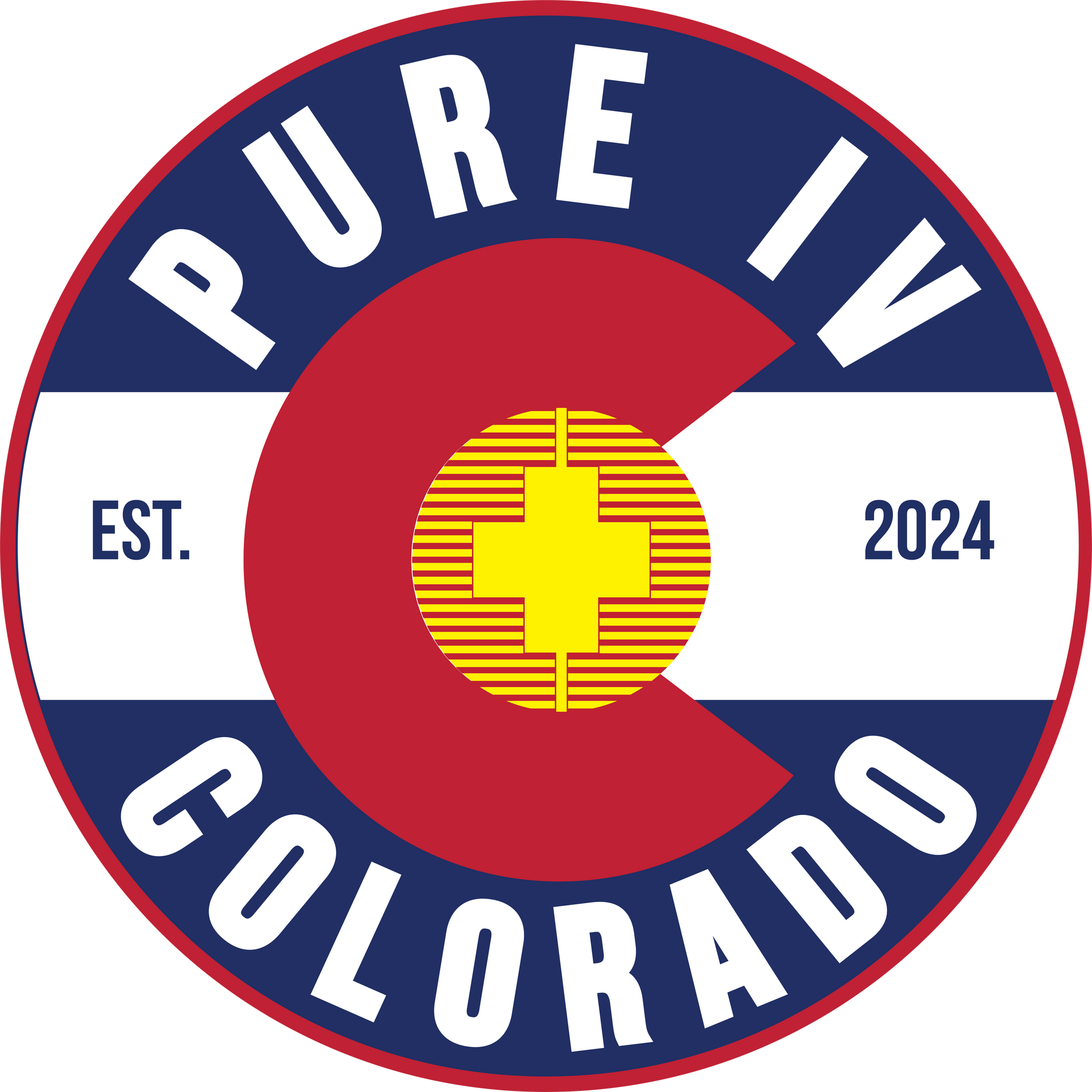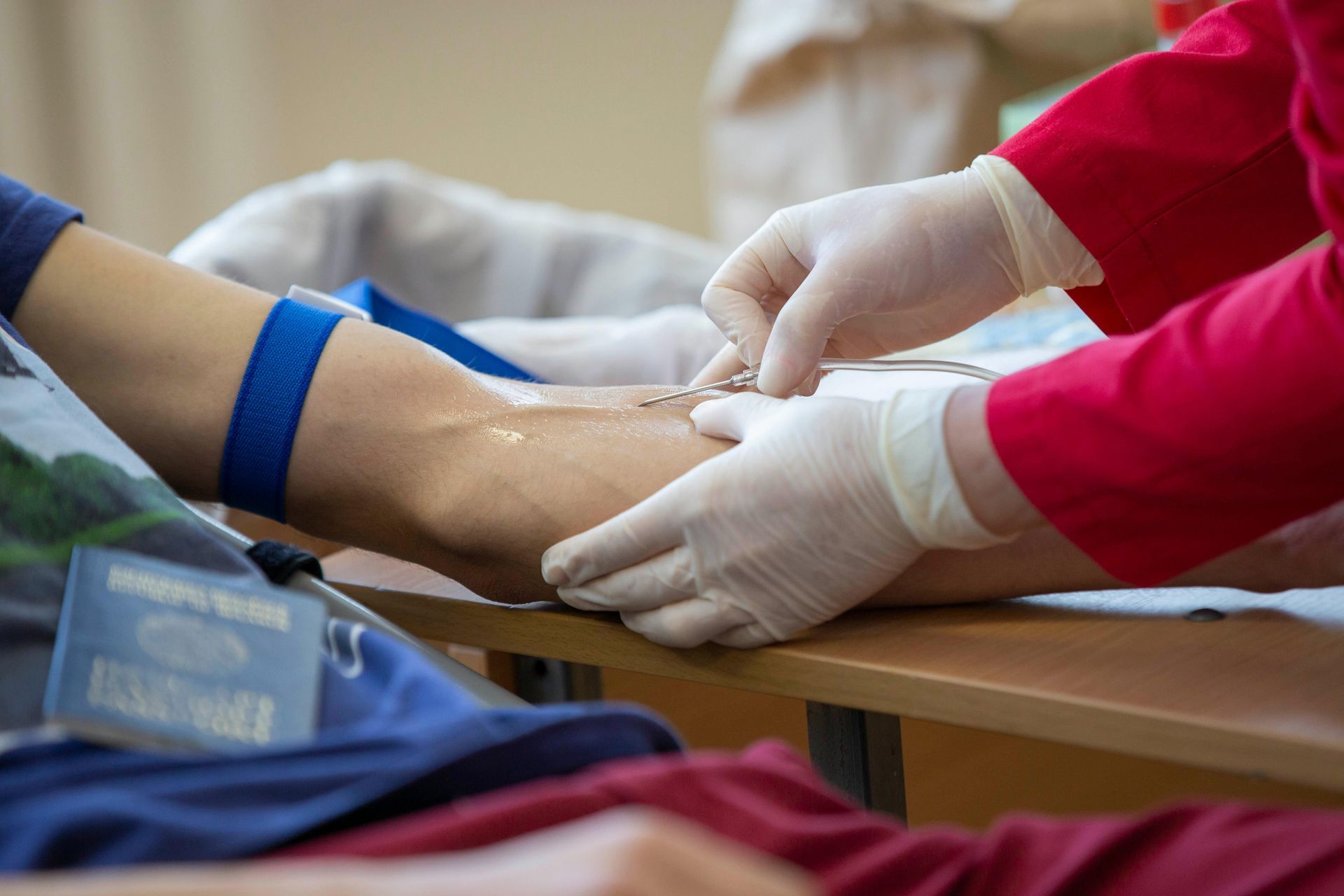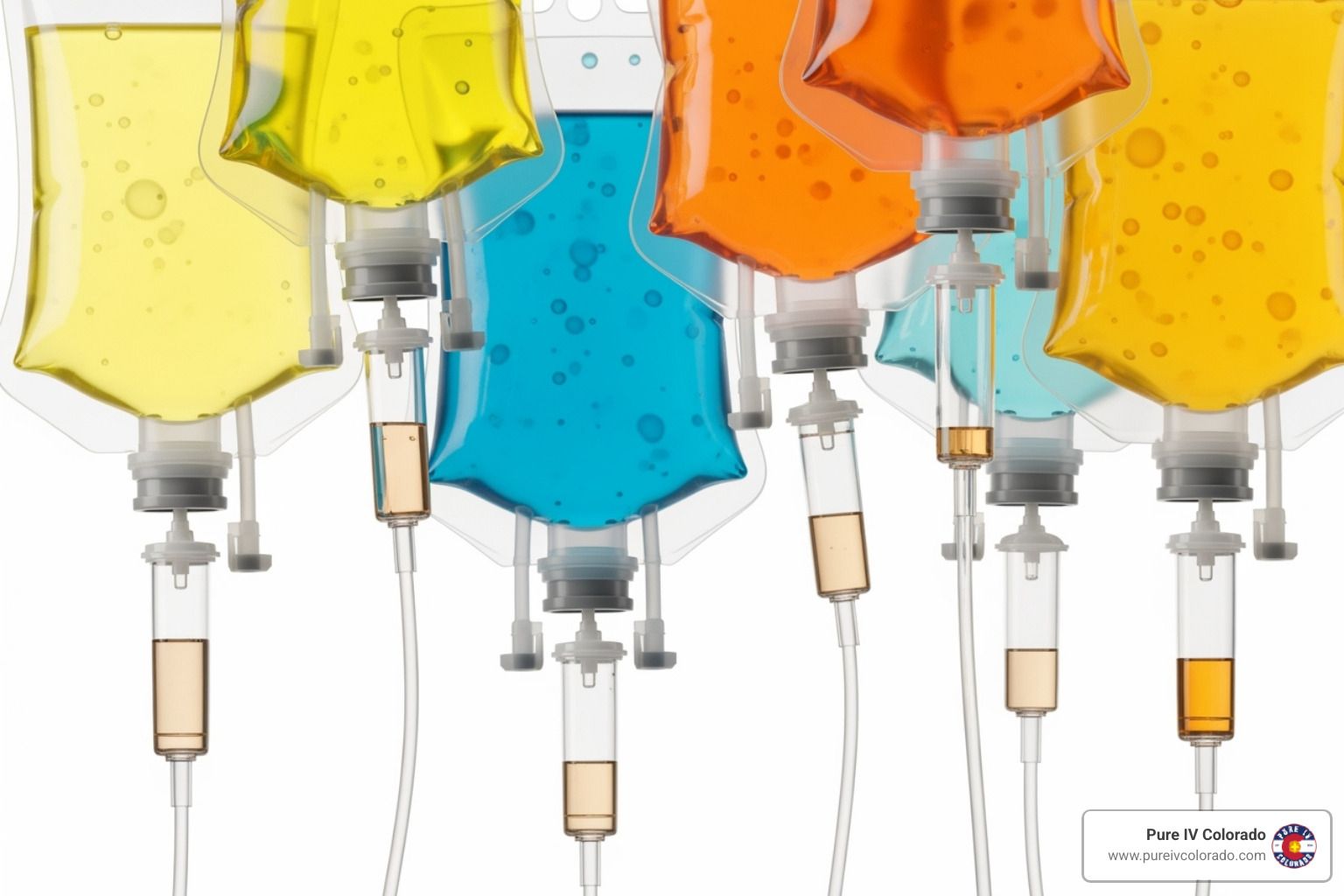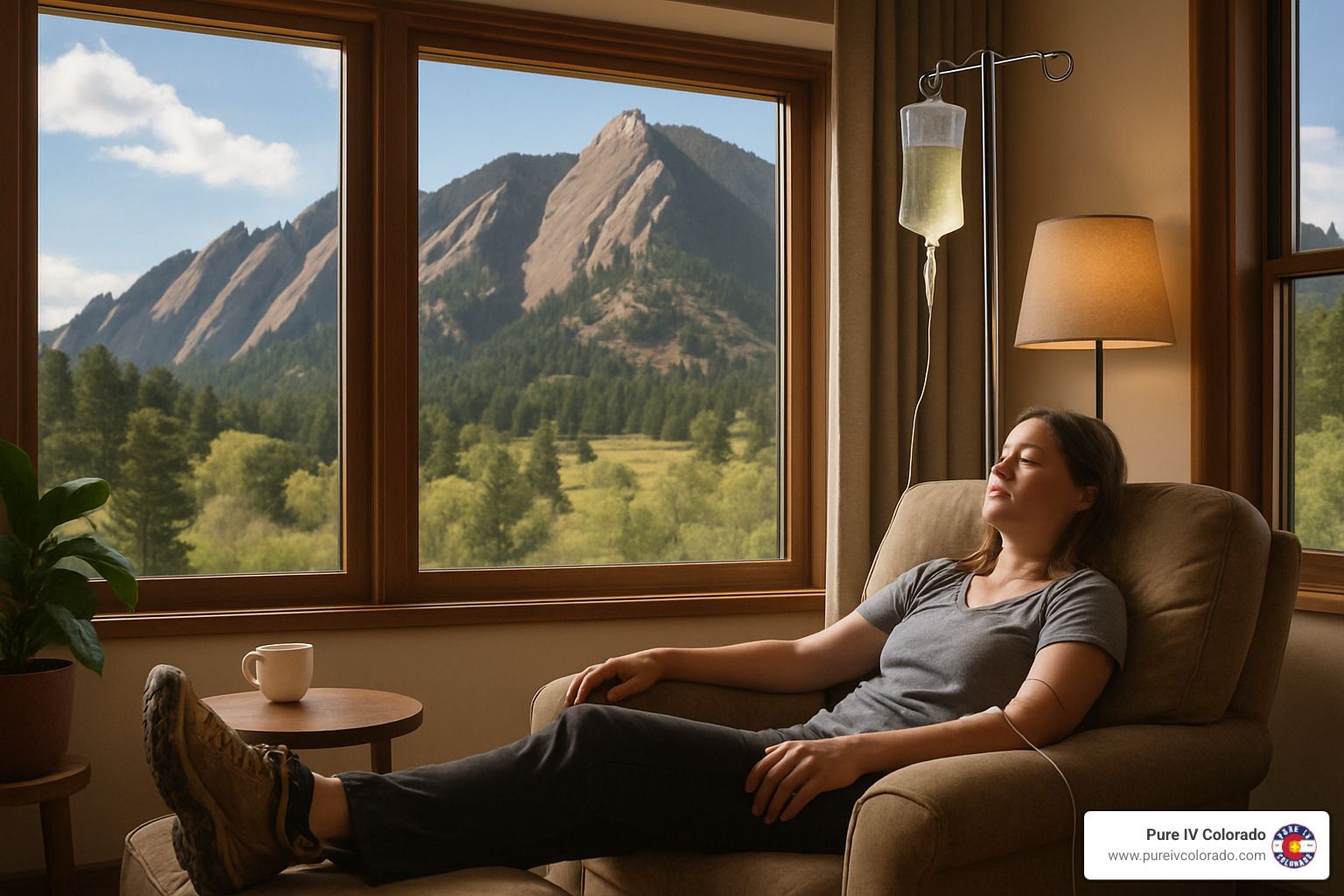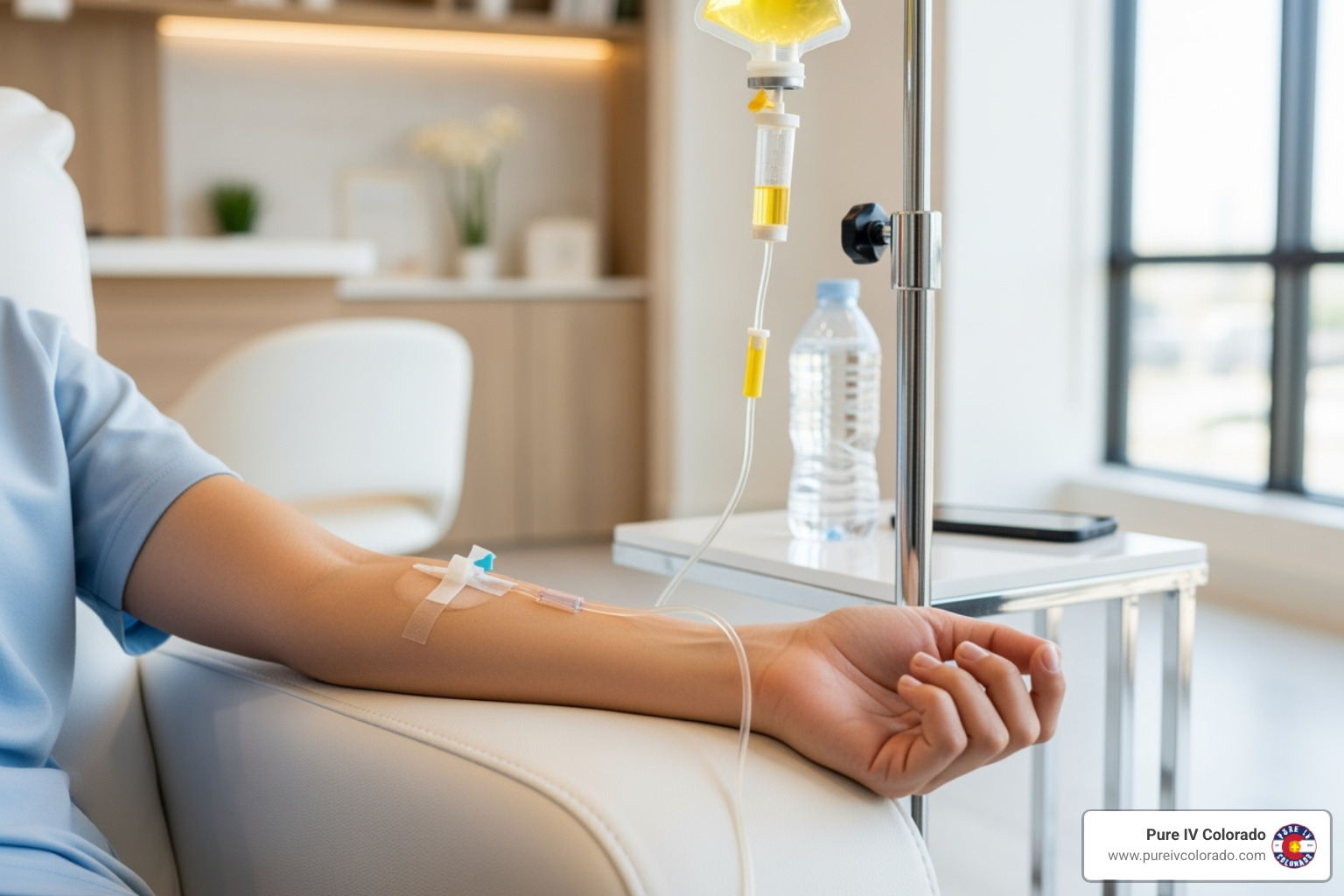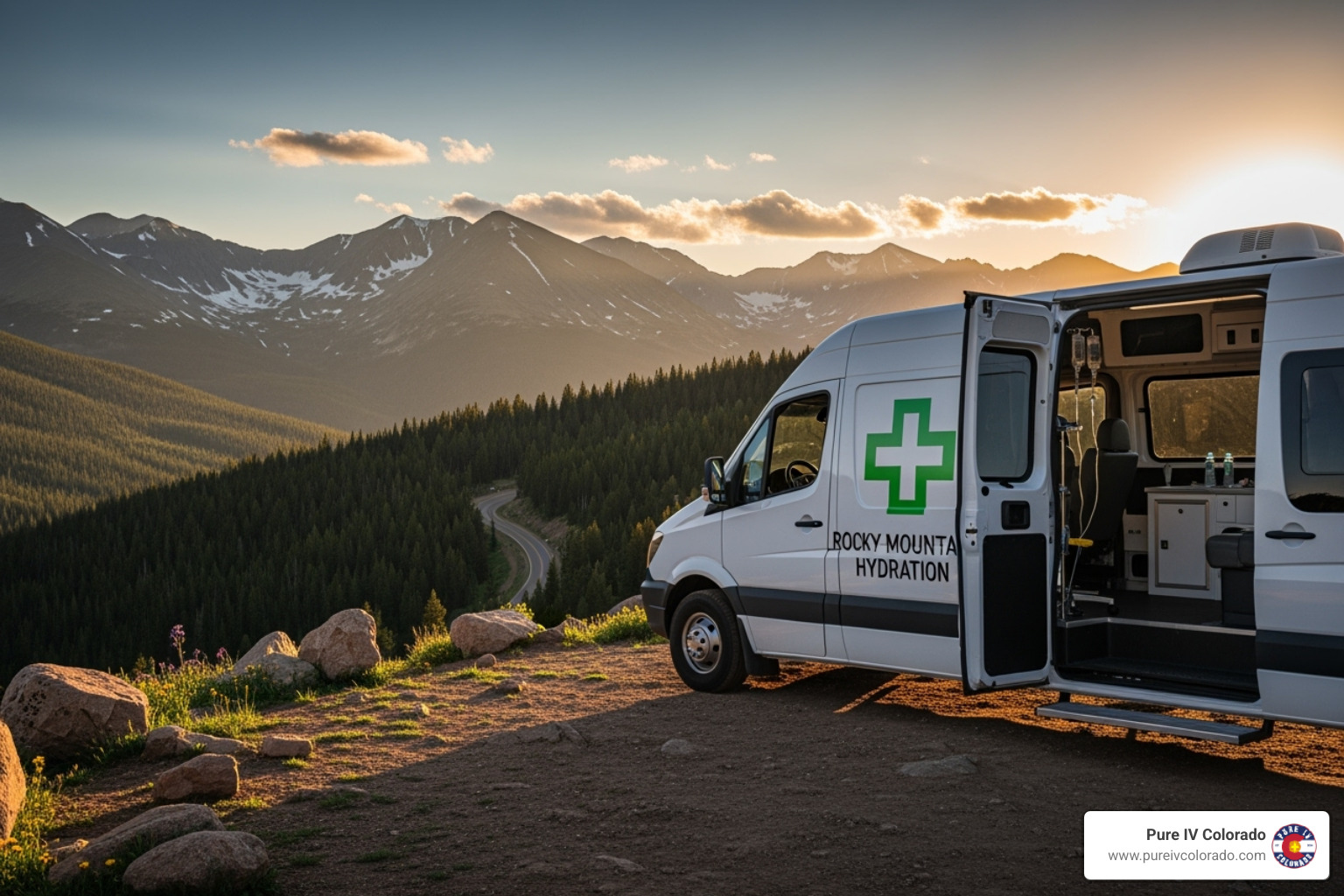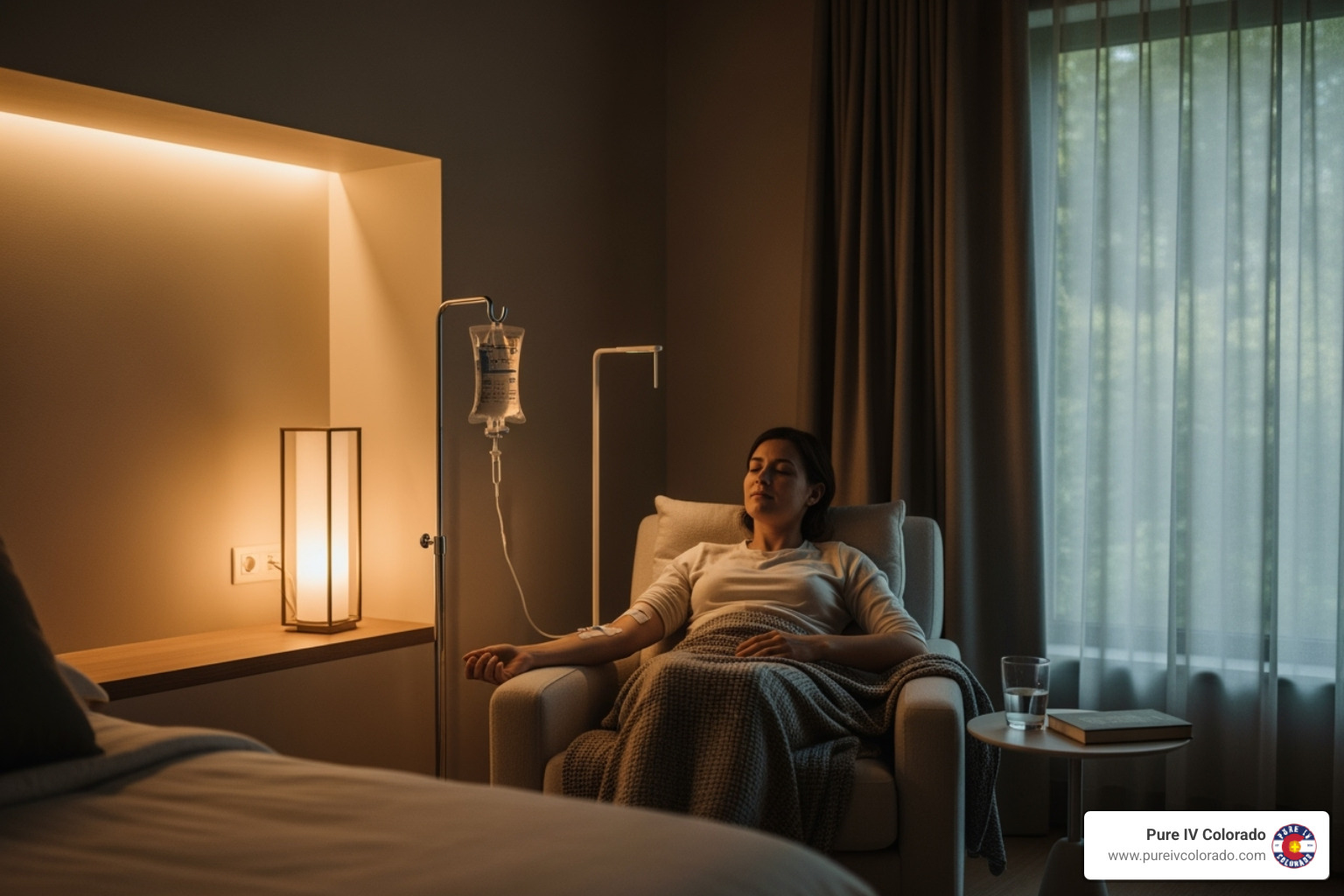Altitude Adjustment Made Easy with IV Therapy
Why Colorado's High Altitude Challenges Your Body

IV therapy for altitude sickness is a fast-acting treatment that delivers hydration, electrolytes, and essential nutrients directly into your bloodstream to combat symptoms like headaches, nausea, and fatigue when your body struggles to adjust to Colorado's thin mountain air.
Quick Answer: What You Need to Know - What it is : Direct intravenous delivery of fluids, vitamins, and medications - How fast it works : Relief typically begins within 30-45 minutes - Key ingredients : Saline, B-complex vitamins, vitamin C, magnesium, zinc, anti-nausea medication - Best for : Headaches, nausea, dizziness, fatigue from altitude exposure - Cost : Usually $175-$300 for mobile service to your location
Colorado's stunning mountain venues sit at elevations where up to 25% of visitors develop acute mountain sickness above 8,000 feet. Whether you're planning a mountain wedding, ski trip, or hiking trip, that picture-perfect high-altitude location can quickly turn uncomfortable when your body can't get enough oxygen.
The thin air at elevation contains significantly less oxygen than at sea level - at 10,000 feet, you're getting about 30% less oxygen with each breath. This oxygen shortage triggers a cascade of symptoms that can derail your special day or outdoor plans.
I'm Joseph Lopez PIVC, founder of Pure IV Colorado, and I've helped hundreds of couples, wedding parties, and mountain triprs overcome altitude challenges through targeted IV therapy for altitude sickness. My team delivers on-site treatments throughout Colorado's high-country destinations, ensuring you can focus on celebrating rather than suffering.

What Happens to Your Body at Altitude?
Picture this: you've just landed in Denver and driven straight up to Breckenridge for your mountain wedding. Within hours, you're nursing a pounding headache and feeling queasy. What's happening isn't in your head - it's a very real physiological response to Colorado's thin air.
When you climb to Colorado's breathtaking elevations, your body immediately notices something's missing: oxygen . The barometric pressure drops significantly as you go higher, which means each breath delivers far less oxygen than your body expects. At around 10,000 feet - where many of Colorado's most popular destinations sit - you're only getting about 69% of the oxygen you'd breathe at sea level.
Your body tries to compensate quickly. Your heart starts racing, working overtime to pump oxygen-poor blood throughout your system. Your breathing becomes faster and shallower as your lungs try to grab every bit of available oxygen. Meanwhile, your brain starts sending distress signals that show up as those familiar altitude sickness symptoms.
This oxygen shortage triggers what doctors call acute mountain sickness (AMS) . Unfortunately, traditional remedies like drinking water or popping pain pills often fall short because they can't address the core problem fast enough. That's where IV therapy for altitude sickness becomes a game-changer - it delivers relief directly into your bloodstream, bypassing your upset stomach entirely.
In rare but serious cases, altitude can cause High Altitude Pulmonary Edema (HAPE) and High Altitude Cerebral Edema (HACE) . While HAPE only affects about 1 in 10,000 Colorado skiers, even mild altitude sickness can turn your dream mountain getaway into a nightmare.

Common Symptoms You Shouldn't Ignore
Altitude sickness doesn't wait around - symptoms typically show up within 6 to 12 hours of reaching elevation and can stick around for 8 to 36 hours without proper treatment.
The persistent headache is usually your first warning sign. It's not just any headache - it's often described as a deep, throbbing pain that doesn't respond well to regular pain relievers.
Nausea and vomiting often follow, creating a frustrating cycle where you can't keep down the fluids your body desperately needs. This is particularly problematic because staying hydrated is crucial for altitude adjustment.
Sleep becomes elusive due to irregular breathing patterns that develop at altitude. You might find yourself waking up frequently or feeling like you can't catch your breath while lying down.
Dizziness and lightheadedness can make simple tasks feel challenging. Your heart rate increases noticeably as your cardiovascular system works harder to deliver oxygen throughout your body.
Many people also experience complete loss of appetite , fatigue and weakness , and shortness of breath during normal activities that would be easy at sea level.
Who Is Most at Risk on Colorado Peaks?
First-time visitors from sea level face the biggest challenge. If you're flying directly from coastal cities to places like Aspen (7,908 feet) or Vail (8,150 feet), your body has zero time to gradually adjust.
Rapid ascent travelers who hop on planes to high-altitude destinations face altitude illness rates approaching 50% when going above 11,150 feet.
People with cardiovascular or pulmonary conditions often experience more severe symptoms. Sleep apnea can worsen at altitude, making nights particularly uncomfortable.
Pregnant women and children require special consideration at high altitudes. Their bodies have different oxygen needs and may respond unpredictably to elevation changes.
Genetic factors play a bigger role than most people realize. Some individuals are simply more susceptible due to how their bodies process oxygen at the cellular level. You might be incredibly fit but still struggle more than your less-active friend.
Alcohol consumption can worsen altitude effects, which is worth considering if you're planning celebration drinks during your mountain visit.
IV Therapy for Altitude Sickness: How It Outperforms Water & Pills
When you're doubled over with nausea at 10,000 feet, trying to choke down another glass of water feels impossible. That's where IV therapy for altitude sickness changes the game completely. Instead of fighting your upset stomach, the treatment delivers everything your body needs directly into your bloodstream with perfect absorption.
When altitude sickness hits with full-force nausea and vomiting, even the best oral medications often come right back up. IV therapy breaks this cycle by bypassing your digestive system entirely.
Our altitude-specific IV formulations work because they deliver 100% bioavailability of every ingredient. While oral treatments might give you 50-70% absorption on a good day, IV delivery ensures your body gets the full benefit of each nutrient and medication. This includes B-complex vitamins that support your energy metabolism, vitamin C for antioxidant protection, magnesium to help regulate blood pressure, zinc for immune support, and glutathione as a powerful antioxidant.
For immediate symptom relief, we add ondansetron (Zofran) to stop nausea and NSAIDs like Toradol to knock out those pounding altitude headaches.
According to scientific research on acute high-altitude illnesses , the direct delivery method provides significantly faster relief than traditional oral treatments.
| Treatment Method | Speed of Relief | Effectiveness | Absorption Rate |
|---|---|---|---|
| Oral Hydration | 2-4 hours | Limited by nausea | 50-70% |
| Oral Medications | 1-2 hours | Often vomited up | Variable |
| IV Therapy | 30-45 minutes | Direct delivery | 100% |
| Descent to Lower Altitude | Immediate | Most effective | N/A |
How Does an Altitude IV Drip Work?
Your body at altitude is essentially running on empty - low oxygen, depleted fluids, and stressed systems trying to keep up. An altitude IV drip works by rapidly expanding your plasma volume with carefully balanced osmolar fluids , typically using Lactated Ringer's solution or normal saline.
This immediate fluid boost helps your cardiovascular system handle the extra workload that high altitude demands. Your heart doesn't have to work as hard to pump blood, and oxygen delivery to your tissues improves dramatically.
Within minutes of starting the infusion, your circulatory system begins functioning more efficiently. The direct bloodstream delivery means every drop of fluid and every nutrient reaches your cells immediately.
Typical Cocktail Ingredients & What Each Does
Our altitude-specific IV cocktails target the multiple ways high elevation affects your body. The saline or Lactated Ringer's solution forms the foundation, rapidly expanding blood volume so your heart can pump more effectively.
Electrolytes including sodium, potassium, and chloride maintain proper cellular function and combat the dehydration that Colorado's dry mountain air accelerates.
Antioxidants like vitamin C and glutathione fight the increased oxidative stress that occurs when your body struggles with reduced oxygen.
Anti-nausea medications such as ondansetron directly stop the queasiness that makes altitude sickness so miserable.
Pain control medications like Toradol provide targeted relief for those throbbing altitude headaches and general body aches.
How Fast Can You Expect Relief?
Most people start feeling better within 30-45 minutes of beginning their IV infusion. The direct bloodstream delivery means relief doesn't have to wait for your digestive system to slowly process medications.
Many clients tell us their headaches begin lifting within the first 30 minutes, and the nausea often disappears even faster. By the time we finish the complete infusion (usually 45-60 minutes), most people feel ready to tackle their planned activities with renewed energy.

Prevention & Rescue: Building Your How-To Plan
Think of altitude sickness prevention like building a fortress - you want multiple layers of protection working together. The gold standard approach combines smart planning with rescue treatments when your body needs extra help.
Gradual ascent remains your best defense. When possible, ascend no more than 500 meters per night once you're above 3,000 meters. I know this isn't always practical for weekend trips, but even one extra day can make a huge difference.
For medication prevention, acetazolamide (Diamox) at 125mg twice daily works well for medium and high-risk travelers. Start taking it the day before you ascend. If you can't tolerate Diamox, dexamethasone provides an alternative option.
Your hydration schedule should begin before you even pack your bags. Start increasing your fluid intake 24-48 hours before your Colorado trip, and keep drinking plenty of water once you arrive. Avoid alcohol during your first 48 hours at elevation.
Carb-rich meals help your body use oxygen more efficiently at altitude. Focus on easily digestible carbohydrates like pasta, rice, and oatmeal.
Can IV Therapy Prevent Altitude Sickness?
While most research on IV therapy for altitude sickness focuses on treating symptoms after they develop, some clients use preventive infusions to give themselves the best possible start at altitude.
A pre-flight IV infusion ensures you arrive optimally hydrated and with peak nutrient levels. This may help your body handle the initial altitude challenge more smoothly, though it's not a magic shield against all symptoms.
We typically recommend preventive IVs for high-risk travelers or anyone with non-negotiable events - like brides who absolutely cannot afford to feel sick on their wedding day.
Safe Combinations With Standard Medications
IV therapy for altitude sickness plays well with standard altitude medications when properly coordinated. Acetazolamide and IV drips work through different mechanisms, so combining them often provides better results than either treatment alone.
If you're using supplemental oxygen from a portable concentrator, IV therapy fills in the gaps that oxygen can't address. Over-the-counter medications like ibuprofen can be used alongside IV therapy, though we often include prescription NSAIDs in our formulations.
Scientific research on prophylaxis guidelines supports this multi-modal approach for optimal altitude sickness management.
Know the Risks & Contraindications
While IV therapy is remarkably safe when administered by trained professionals, we always discuss potential risks honestly. Infection at the injection site is possible but rare when proper sterile technique is followed.
Fluid overload concerns people with heart or kidney disease, since these organs may struggle to process additional fluid. We always review your medical history before treatment.
Medication allergies require careful attention. We thoroughly review all allergies before selecting your IV additives.
Venous access challenges can make IV placement tricky, especially when you're already dehydrated. Our experienced nurses excel at IV placement, but occasionally we need to try different approaches.

Accessing Mobile IV Therapy in the Mountains
Getting IV therapy for altitude sickness shouldn't mean driving down the mountain when you're already feeling awful. That's why we bring our mobile service directly to you throughout Colorado's high-country destinations.
Our team regularly travels to popular mountain locations including Breckenridge, Vail, Aspen, Boulder, and dozens of other ski resorts and wedding venues where altitude sickness commonly strikes. Whether you're staying at a luxury resort, cozy mountain cabin, or event venue, we'll come to your location with everything needed for professional IV treatment.
The convenience factor is huge when you're dealing with altitude sickness symptoms. Instead of navigating winding mountain roads while feeling nauseous and dizzy, you can rest comfortably while we handle the treatment.
Pricing for mobile altitude IV therapy typically ranges from $175-$300, depending on which formulation and add-ons work best for your symptoms. HSA and FSA accounts often cover IV therapy when it's treating a medical condition like altitude sickness. We provide detailed receipts that you can submit for reimbursement.
The booking process is straightforward - we just need to know your location, preferred timing, and which symptoms you're experiencing. Our team handles the rest, arriving with medical-grade equipment and everything needed for safe, effective treatment.
When to Call 911 Instead of Ordering a Drip
While IV therapy for altitude sickness works wonderfully for typical symptoms like headaches and nausea, some situations require immediate emergency care.
Worsening AMS symptoms that don't improve with rest are a red flag. If someone has a severe headache that doesn't respond to pain medication, persistent vomiting, or extreme fatigue, it's time for emergency medical attention.
Ataxia - loss of coordination and balance - is a serious warning sign of high altitude cerebral edema (HACE). If someone can't walk in a straight line or appears confused, they need immediate evacuation to lower altitude.
Confusion or personality changes indicate potential brain swelling and require emergency treatment. These symptoms can progress rapidly and become life-threatening.
Cyanosis (blue lips or fingernails) or severe chest tightness may signal high altitude pulmonary edema (HAPE). This condition requires immediate oxygen therapy and evacuation.
When in doubt, err on the side of caution. Severe altitude sickness can be life-threatening.
Practical Tips for Travelers & Event Planners
Book your IV therapy in advance , especially during peak seasons. Colorado's mountain destinations get busy, and you don't want to wait when you're feeling awful.
Morning appointments work best for most people. Getting your IV therapy early gives you the full day to enjoy improved energy and hydration.
Consider pairing IV therapy with oxygen rental for comprehensive altitude support. Many clients find this combination particularly effective for multi-day mountain events.
For wedding parties and group events , we can treat multiple people at once. This makes it efficient and fun for entire bridal parties to receive treatment together.
Plan for the weather - mountain weather can change quickly. Let us know if there are any access issues to your location so we can plan accordingly.

Frequently Asked Questions About IV Therapy for Altitude Sickness
How soon before ascent should I schedule a preventive IV?
The sweet spot for preventive IV therapy for altitude sickness is within 12-24 hours before you reach high altitude. Think of it like filling up your gas tank before a long road trip - you want to arrive at your destination with everything your body needs already on board.
If you're flying directly from sea level to places like Aspen or Breckenridge, I recommend getting your IV the morning of departure or the evening before your flight. This timing ensures you step off that plane already well-hydrated and loaded with the nutrients your body will need.
For big mountain events like destination weddings, many clients book a preventive IV before traveling, then keep our number handy just in case symptoms pop up later.
Is IV therapy safe for children or pregnant travelers?
IV therapy for altitude sickness requires special care when it comes to kids and expecting mothers.
For children, we typically don't provide IV treatments for anyone under 100 pounds. Kids' bodies process medications and fluids differently than adults, and their smaller size means dosing becomes much more complex. The good news? Children often adapt to altitude faster than adults, so gentle approaches like extra rest and increased fluids usually work well.
Pregnant travelers need individualized care that goes beyond what we can provide in a mobile setting. We always recommend pregnant women consult with their doctor before traveling to high altitude and stick with proven safe approaches like gradual ascent and plenty of rest.
Can I continue hiking right after my infusion?
While most people feel dramatically better within 30-45 minutes of IV therapy for altitude sickness , your body is still working hard to adjust to Colorado's thin air.
Think of the IV as giving your body the tools it needs to do the job, not as a magic cure that makes altitude disappear. You'll likely feel ready to conquer the world, but your cells are still adapting to getting less oxygen with each breath.
Light activities like strolling through downtown Breckenridge or enjoying a leisurely lunch are perfect after your treatment. But save the challenging hikes or intense ski runs for tomorrow or the day after.
The general rule I give clients is to wait 24-48 hours after feeling better before jumping into strenuous activities. This gives your body time to complete the acclimatization process.

Conclusion
When altitude sickness threatens to derail your Colorado mountain trip, IV therapy for altitude sickness provides the fastest path back to feeling great. While sipping water and hoping for the best might work eventually, direct bloodstream delivery of hydration and nutrients gets you back on your feet in 30-45 minutes instead of waiting hours.
You've planned this amazing Colorado trip, maybe even your dream mountain wedding, and suddenly you're stuck with a pounding headache and nausea. That's exactly when IV therapy for altitude sickness becomes your best friend, delivering relief right to your location so you don't miss another precious moment.
Our Pure IV Colorado mobile team has perfected altitude-adapted treatments specifically for Colorado's unique high-elevation challenges. Whether you're saying "I do" at 10,000 feet or tackling your first fourteener, feeling terrible isn't an option. That's why we've developed IV formulations that work with your body's natural acclimatization process.
From Denver to Breckenridge, from Boulder's foothills to Colorado Springs' mountain backdrop, we bring professional IV therapy directly to you. No driving to clinics when you feel awful, no waiting rooms when you should be celebrating - just fast, effective treatment wherever you are.
The beauty of our service isn't just the convenience. It's knowing that someone understands exactly what you're going through and has the expertise to help you feel human again quickly. We've seen countless couples transform from miserable to radiant within an hour of treatment, ready to dance at their reception or pose for those once-in-a-lifetime mountain photos.
Don't let Colorado's thin air steal your thunder. With smart preparation, gradual ascent when possible, and IV therapy for altitude sickness as your backup plan, you can conquer everything our beautiful state offers - from intimate alpine ceremonies to epic hiking trips - feeling absolutely amazing.
